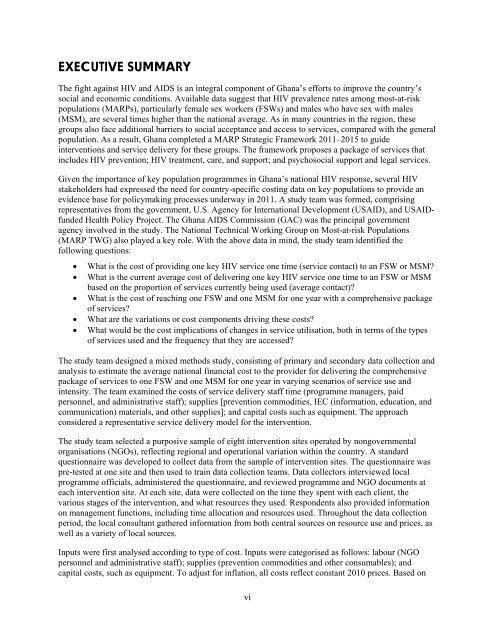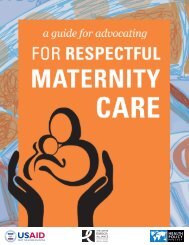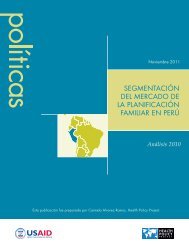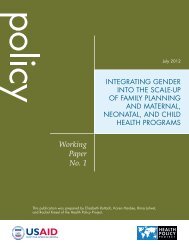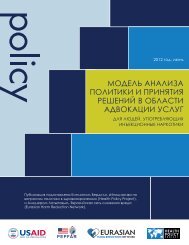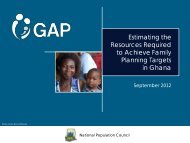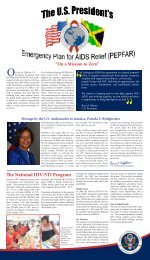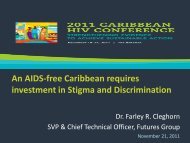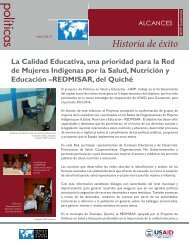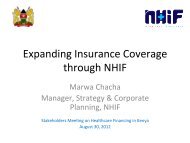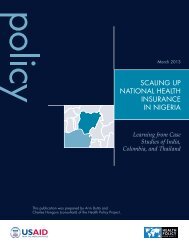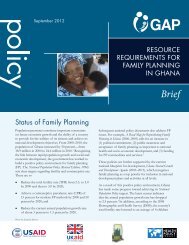Working Paper No. 6 - Health Policy Project
Working Paper No. 6 - Health Policy Project
Working Paper No. 6 - Health Policy Project
You also want an ePaper? Increase the reach of your titles
YUMPU automatically turns print PDFs into web optimized ePapers that Google loves.
EXECUTIVE SUMMARY<br />
The fight against HIV and AIDS is an integral component of Ghana’s efforts to improve the country’s<br />
social and economic conditions. Available data suggest that HIV prevalence rates among most-at-risk<br />
populations (MARPs), particularly female sex workers (FSWs) and males who have sex with males<br />
(MSM), are several times higher than the national average. As in many countries in the region, these<br />
groups also face additional barriers to social acceptance and access to services, compared with the general<br />
population. As a result, Ghana completed a MARP Strategic Framework 2011–2015 to guide<br />
interventions and service delivery for these groups. The framework proposes a package of services that<br />
includes HIV prevention; HIV treatment, care, and support; and psychosocial support and legal services.<br />
Given the importance of key population programmes in Ghana’s national HIV response, several HIV<br />
stakeholders had expressed the need for country-specific costing data on key populations to provide an<br />
evidence base for policymaking processes underway in 2011. A study team was formed, comprising<br />
representatives from the government, U.S. Agency for International Development (USAID), and USAIDfunded<br />
<strong>Health</strong> <strong>Policy</strong> <strong>Project</strong>. The Ghana AIDS Commission (GAC) was the principal government<br />
agency involved in the study. The National Technical <strong>Working</strong> Group on Most-at-risk Populations<br />
(MARP TWG) also played a key role. With the above data in mind, the study team identified the<br />
following questions:<br />
• What is the cost of providing one key HIV service one time (service contact) to an FSW or MSM<br />
• What is the current average cost of delivering one key HIV service one time to an FSW or MSM<br />
based on the proportion of services currently being used (average contact)<br />
• What is the cost of reaching one FSW and one MSM for one year with a comprehensive package<br />
of services<br />
• What are the variations or cost components driving these costs<br />
• What would be the cost implications of changes in service utilisation, both in terms of the types<br />
of services used and the frequency that they are accessed<br />
The study team designed a mixed methods study, consisting of primary and secondary data collection and<br />
analysis to estimate the average national financial cost to the provider for delivering the comprehensive<br />
package of services to one FSW and one MSM for one year in varying scenarios of service use and<br />
intensity. The team examined the costs of service delivery staff time (programme managers, paid<br />
personnel, and administrative staff); supplies [prevention commodities, IEC (information, education, and<br />
communication) materials, and other supplies]; and capital costs such as equipment. The approach<br />
considered a representative service delivery model for the intervention.<br />
The study team selected a purposive sample of eight intervention sites operated by nongovernmental<br />
organisations (NGOs), reflecting regional and operational variation within the country. A standard<br />
questionnaire was developed to collect data from the sample of intervention sites. The questionnaire was<br />
pre-tested at one site and then used to train data collection teams. Data collectors interviewed local<br />
programme officials, administered the questionnaire, and reviewed programme and NGO documents at<br />
each intervention site. At each site, data were collected on the time they spent with each client, the<br />
various stages of the intervention, and what resources they used. Respondents also provided information<br />
on management functions, including time allocation and resources used. Throughout the data collection<br />
period, the local consultant gathered information from both central sources on resource use and prices, as<br />
well as a variety of local sources.<br />
Inputs were first analysed according to type of cost. Inputs were categorised as follows: labour (NGO<br />
personnel and administrative staff); supplies (prevention commodities and other consumables); and<br />
capital costs, such as equipment. To adjust for inflation, all costs reflect constant 2010 prices. Based on<br />
vi


